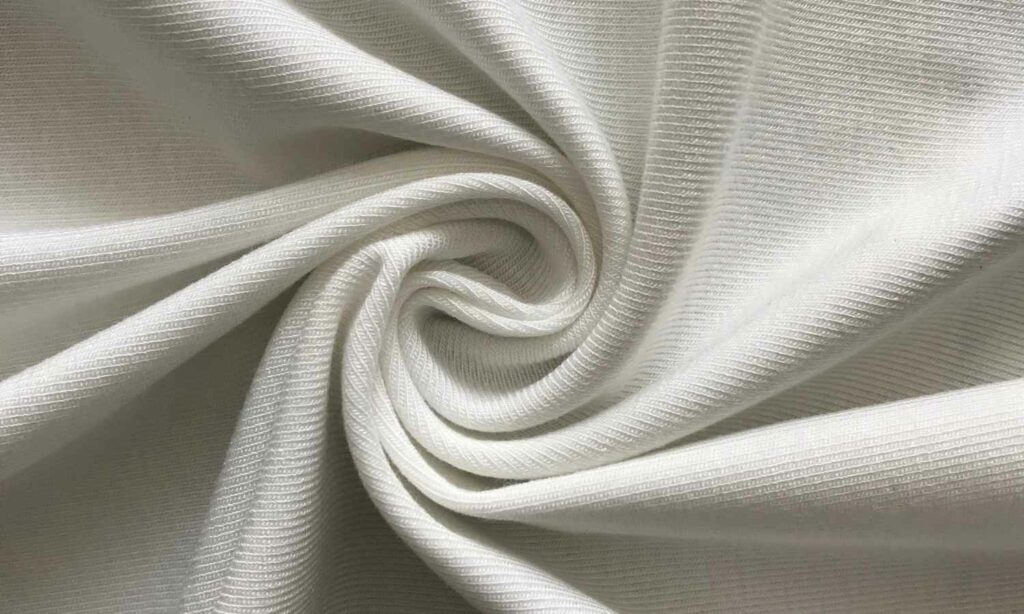Modal fabric is a semi-synthetic fabric often combined with other materials (like cotton) to create many clothing items today, such as underwear. Because of its soft, lightweight, and breathable feel, Modal has also become a popular choice for activewear as well.
Not only is it a silky and breathable material, but it’s also considered more eco-friendly than other fabrics like cotton and polyester. Brands market with pride that it has a lower environmental impact, but is it too good to be true?
Although modal is commonly claimed as eco-conscious, there is a lot more nuance to this assertion than one might think. Read further to explore all there is to know about modal fabric.
What is Modal Fabric?
Properties of Modal
Modal is a semi-synthetic material often sourced from beechwood trees. The wood source, however, differs from company to company (if they care about the environment, they’ll choose beechwood!)
Modal is quite similar to rayon/viscose and is referred to as second-generation rayon. It was first developed in Japan in the 1950s as an alternative to rayon and a cheaper alternative to silk.
The Austrian company, Lenzing AG, owns the trademark for Lenzing Modal and currently manufactures most of the modal out on the market. Lenzing’s mission on making fabrics with less environmental and social impacts, with TENCEL lyocell as a true testament to their sustainability-centered innovations.
Overall, many brands use modal as a high-end and eco-friendly material as part of their collection. Modal can be used in various products, such as underwear, cotton blend garments, activewear, shirts, and even bedding.
Pros and Cons of Modal
Especially when compared to rayon/viscose and cotton, here are some
Pros:
- Resistant to shrinking and stretching when wet
- Breathable
- 50% more water absorbent than cotton (great for activewear and socks)
- Drapes well (good alternative to silk)
- Less chemicals required during production (although it depends on the producer)
However, modal is more expensive, and some properties may change when modal is blended with other fabrics, which is common. With that said, here are some of the cons of modal fabric.
Cons:
- Sustainable sourcing/production is not guaranteed, since it depends on the manufacturer
- Harsh chemicals can be used to remove cellulose from modal
- It’s not hypoallergenic; some people may have an allergic reaction
- Doesn’t retain heat, so it can’t be used in cold weather
Production of Modal Fabric
Modal fabric is produced in a fashion similar to rayon/viscose, bamboo, and lyocell, but has some differences. It is plant-derived, usually from beechwood trees.
Because beech trees do not need as much water to grow, the process doesn’t require as much water or chemicals as some other fabrics. This alone makes it a more eco-friendly option than cotton.
When produced, beech trees are first harvested and chipped to extract cellulose from the pulp and the cellulose is then made into sheets. The sheets are then soaked with sodium hydroxide, but compared to viscose/rayon, less sodium hydroxide is required.
After more steps of chipping and soaking in chemicals like sodium hydroxide and sulfuric acid, a spinneret is used to create yarn. Finally, fibers are bleached and dried, and then it’s ready for garment-making!
A plus of modal fabric is that it is easy to dye with natural dyes. That being said, chemical dyes may still be used if the producer decides to use them. Therefore, look for Lenzing-produced modal because Lenzing uses a spin-dyeing process that creates 30-50% less pollution than conventionally-dyed fabric.
RELATED: Everything You Need to Know About Tencel Fabric
Is Modal Sustainable?
The sustainability of modal fabric depends significantly on its sourcing and production process. Below, we break down the different aspects of sourcing and production options for modal.
Responsible Sourcing of Modal
Considerations must begin at the very start of modal fabric’s life cycle: the source. A common misconception, probably due to its excessive marketing, is that modal is only sourced from beechwood trees. This, however, is false. Any wood pulp can be used for modal.
The alternative to beechwood is often Woodstock from areas of the rainforest and pulpwood plantations (as exposed by Rainforest Alliance) which contributes to deforestation. Brands may label rayon fabrics made from these sources as “renewable” or “natural.”
To avoid buying modal that contributes to deforestation, look for transparent brands that prove responsible sourcing from beechwood trees and sustainably certifications, as demonstrated by Lenzing modal.
In addition to avoiding deforestation, sustainably harvested beechwood uses significantly less water, resulting in 10 to 20 times less water throughout the production process.
Manufacturing
The manufacturing of modal fabric also varies from producer to producer, hence varying environmental and social impacts. The recommendation here, no surprise, is to purchase products with Lenzing modal, since the manufacturing is a closed-loop. This minimizes waste, plus over 99% of water and solvent are recycled and reused.
Other manufacturers differ in environmental and social standards, and a red flag is modal made in countries with less strict environmental and labor laws, like China, India, Pakistan, and Indonesia. Modal fabric can still be made with toxic chemicals, like non-natural dyes, less energy-efficient factories, and by workers in poor labor conditions.
Bottom Line
At the very least, shopping for semi-synthetic materials like modal is better than shopping for synthetic materials like rayon and polyester.
When sourced and produced responsibly, modal is a great eco-friendly option because beechwood is a renewable plant and requires little water. Plus, natural dyes work well on modal fabric.
If you come across modal fabric that is not produced by Lenzing, make sure the brand provides transparency on its supply chain and manufacturing to determine sustainability.
The quality of modal fabric is desirable because of its luxurious softness and durability. Although more expensive than cotton, products with modal are softer, long-lasting, and better able to absorb moisture, so at least check out modal fabrics for activewear and socks!

